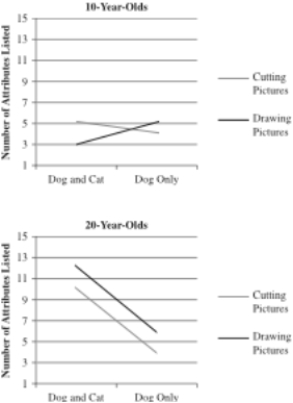Dr. Elder was interested in the way people recognize objects as members of categories. For example, what makes us recognize a dog as being a dog and not a cat? More specifically, he was curious as to whether people think about categories in a more complex way if they contemplate an "opposite" category first. For example, does a person think more differently about the category of "southern" if they are also thinking about the category of "northern"? He is also curious as to whether people categorize differently if they are exposed to category members compared with generating category members. Dr. Elder has four groups of participants (with 30 people in each group) . In Group A, participants were told to cut out pictures of dogs and cats from magazines. In Group B, participants were told to cut out pictures of just dogs from magazines. In Group C, participants were told to draw pictures of cats and dogs. In Group D, participants were told to draw pictures of just dogs. After doing this for 30 minutes, participants in all groups were asked to list the attributes that define the "dog" category. Having a higher number of attributes listed was considered to be an indication of thinking about the category in a more complex way.
Dr) Elder also is curious as to whether categorization happens similarly for children as it does for adults. As such, he recruits a group of 10-year-olds and a group of 20-year-olds to participate in the study. The results are below.
Dr) Elder will need to examine how many two-way interactions?
Definitions:
Child Development
The study of the psychological, physical, and emotional changes that occur in children from birth through late adolescence.
Phonemes
The basic and distinct units of sound in a specified language that distinguish one word from another, for example, the difference in sound between the p in "pat" and the b in "bat".
Word Pronunciation
The manner in which a word is expressed or sounded out vocally, often subject to variations based on language, dialect, or individual speech patterns.
Syntax
The set of rules and principles that govern the structure of sentences in a language, determining how words are combined to convey meaning.
Q2: The mathematical way to describe an interaction
Q2: Dr. Smitherman conducted a study 5 years
Q12: Name the three types of internal reliability
Q13: iminostilbene
Q13: Dr. Guidry conducts a study examining the
Q15: Which of the following drugs were not
Q16: Tofranil
Q22: Lauren, Sarah, and Jennifer are students in
Q29: Statistical significance depends on which of the
Q30: Dr. Green is interested in conducting a